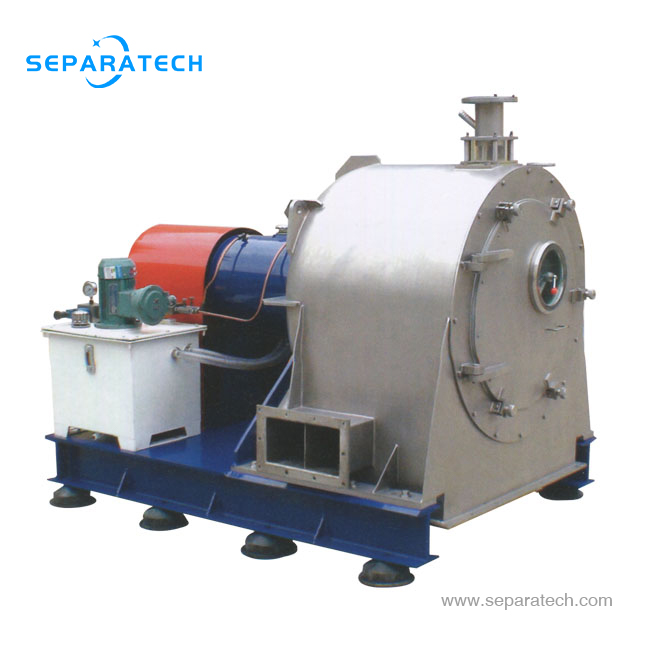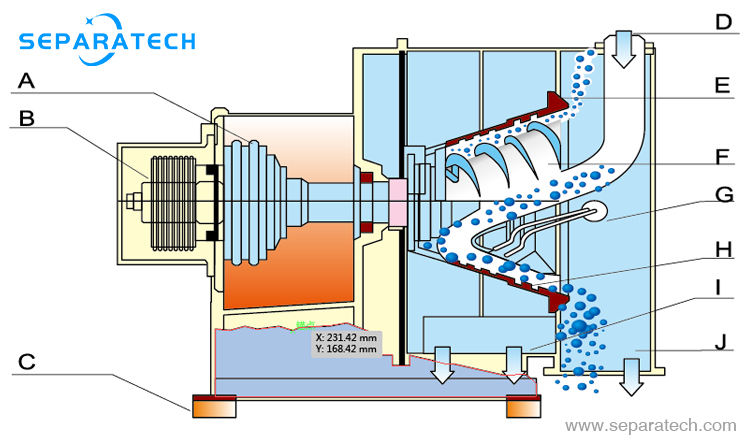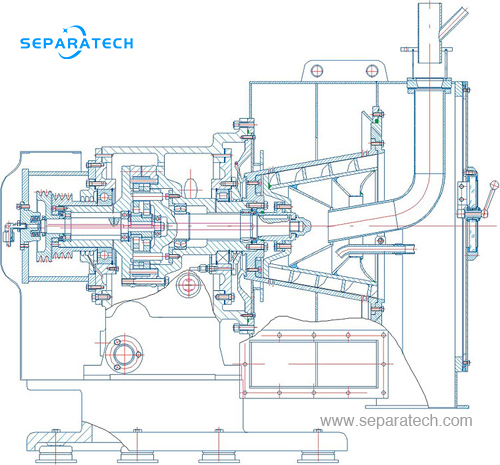
Horizontal Screen Scroll Centrifuge
The horizontal screen scroll centrifuge of SEPARATECH is a continuously centrifuge for liquid – solids separation. It has a broad range of applications. We achieve this flexibility by means of a centrifuge scroll driven at a differential speed.
There are thousands of horizontal screen scroll centrifuges in operation in the most varied industrial sectors worldwide. They perform tasks in the chemical industry with specific corrosion-resistance requirements or gas-tight processes as well as fulfilling hygiene requirements in the food industry.
How it works

A: Gearbox
B: Belt
C: Damper
D: Feeding inlet
E: Bowl
F: Screw
G: Flushing inlet
H: Screen
I: Liquid outlet
J: Solids outlet
The horizontal screen scroll centrifuge is composed of a drive unit located in a bearing housing, the screen retaining basket, the screen element, the transport worm and the product housing enclosing the rotating parts.
Inside the basket and screen is a concentrically located worm where the flight tips are set at a clearance of 0.5 – 4 mm from the screen surface.
The solids/liquid mixture flows into the horizontal screen scroll centrifuge via a central feed pipe to the inside of the worm. The interior of the worm has a feed cone that preaccelerates the slurry and also distributes it uniformly onto the screening element inside the rotating basket.
These components make up the rotating wetted parts which are of single bearing design cantilevered from the drive housing. The worm rotates at a slightly different speed than the screen basket which results in uniform product acceleration and distribution. This makes the machine very insensitive to fluctuations in the feed concentration and other operating conditions.
The solids/liquid mixture enters the rotating components in the area of the smallest diameter and the majority of liquid is separated through the screen.
In this area the circumferential speed is lowest resulting in smaller power demand compared to cylindrical design machines for the same purpose.
Most solids will slide toward the largest diameter under the influence of centrifugal force, where they are discharged into the product housing over the open basket end. If the solids try to stick to the screening surface, the worm pushes them forward and if the solids try to slide out too quickly, the worm holds them inside the basket. The transport worm acts as a control mechanism by regulating the solids` sliding speed and retention time. If the coefficient of friction of the wet solids is low, the flights hold the solids back, and near the discharge end of the screen basket if the dewatered solids friction force is high against the screen, the worm will advance the solids to discharge.
Technical parameters

Material
All process contact parts can be manufactured in corrosion-resistant, austenitic steels, Hastelloy, nickel, titanium, etc. depending on the particular application. In all applications, proper wear protection is available for abrasive feed material.
CIP – cleaning
CIP capability is optional. Horizontal screen scroll centrifuge can be equipped with spray nozzles, so the machines are self-cleaning. For special requirements, the centrifuge can be provided with a CIP cleaning system. Included are special washing tubes, nozzles and if necessary, a slow speed drive to allow flooding of the product contact parts.
Applications
Adipic Acid
AH-Salt
Amino Acetic Acid
Ammonium Persulphate
Ammonium Phosphate
Ammonium Sulphate
Ammonium Thiosulphate
Anthracene
Aspirin
Bisphenol
Borax
Calcium Formiate
Carboxy-Methylcellulose
Celluloid Wool
Cellulose Wool
Chocolates (broken)
Citric Acid
Coal Slurry
Coffee Freeze Concentrate
Coffee Grounds
Copper Sulphate
Cotton Linters
Crystal Soda
Date Stones
Dimethylterephthalate
Dipterex
Disodium Phosphate
Finely chopped onions
Fungal Mycel
Glacial Acetic Acid
Glauber Salt
Greaves
Gypsum
Hops frome
Methylene Chloride
Ion Exchange Resin
Ironsulphate Heptahydrate
Lactose
Manganese Sulphate
Methylcellulose
Monosodiumphosphate
Naphtionate
Nuts (broken)
Nylon Chips
Oxalic Acid
Patent Soda
Pearl Polymerisate
Pentaerythrite
Plastic Granules
Plexiglas Beads
Polyethylene
Polymethacrylate
Polystyrene
Polyvinylalcohol
Potash
Potash Alum
Potash Solvent Residue
Potassium Bicarbonate
Potassium Bichromate
Potassium chloride
Potassium Monochromate
Potassium Pensulphate
Potassium Phosphate
Potassium Sulphate
PVA
PVC
Pyrazolene
Rock Salt
Rubber Regenerate
Silver Nitrate
Sodium Acetate
Sodium Bisulphite
Sodium Carbonate
Sodium Chlorate
Sodium Chloride
Sodium Formiate
Sodium Gluconate
Sodium Metaborate
Sodium Nitrate
Sodium Nitre
Sodium Perborate
Sodium Phosphate
Sodium Sulphate
Sodium Sulphite
Sodium Tetraborate
Sodium Thiosulphate
Tartaric Acid
Tin Sulphate
Trisodium Phosphate
Vegetables
Vegetable Extracts
Zinc Sulphate
and many others
